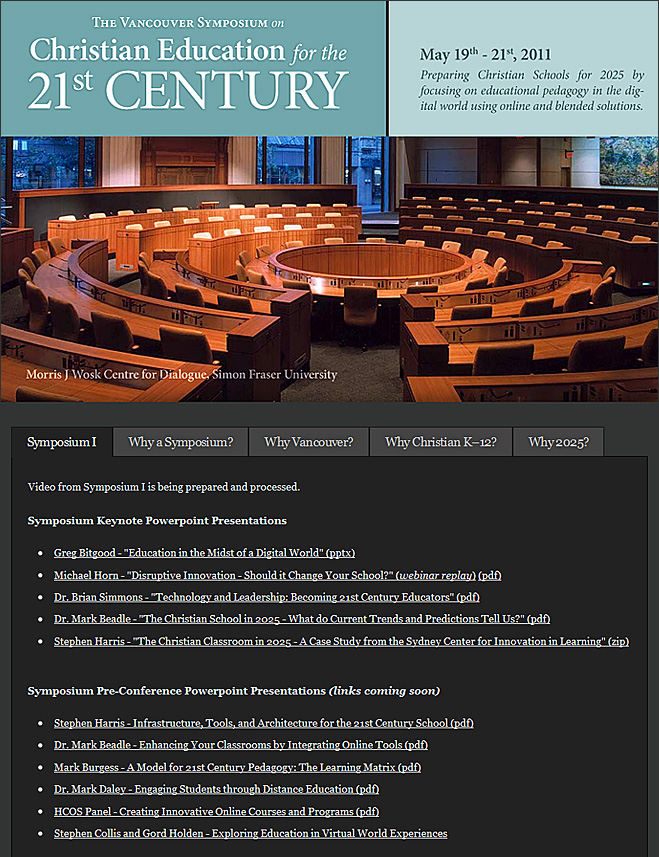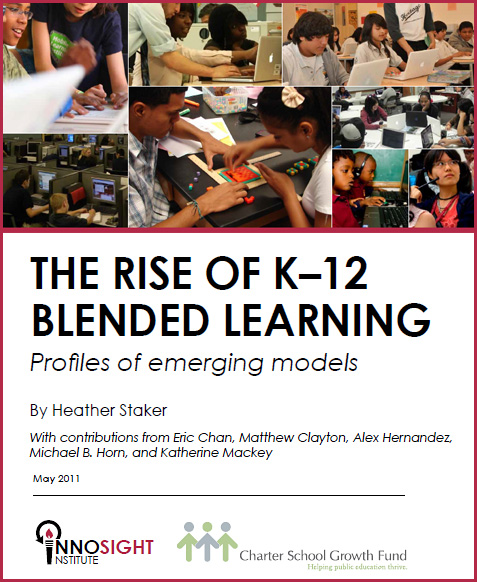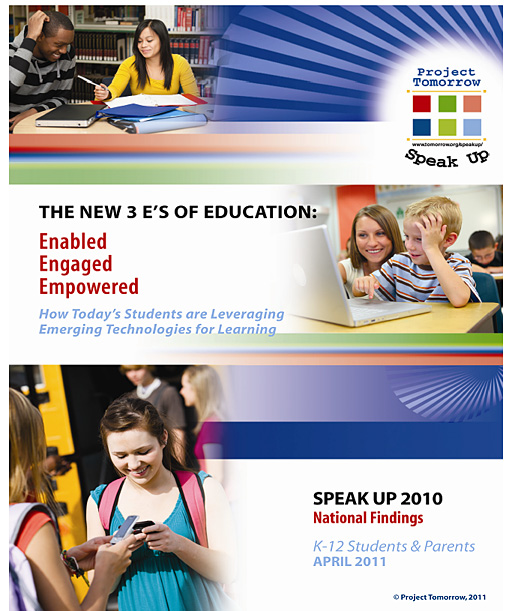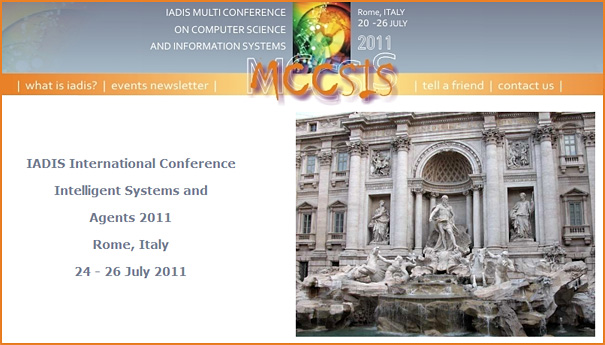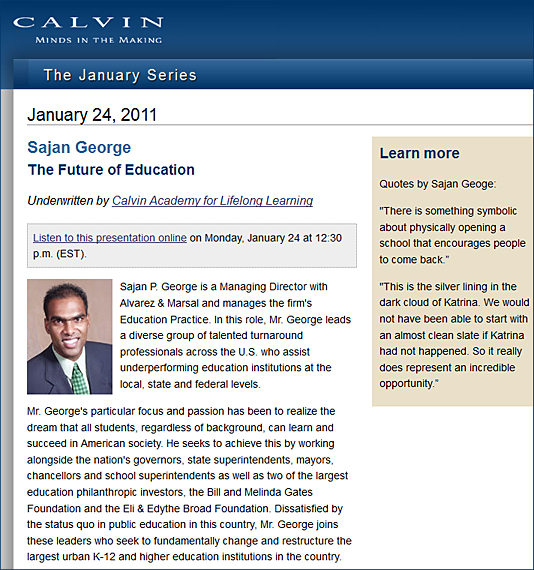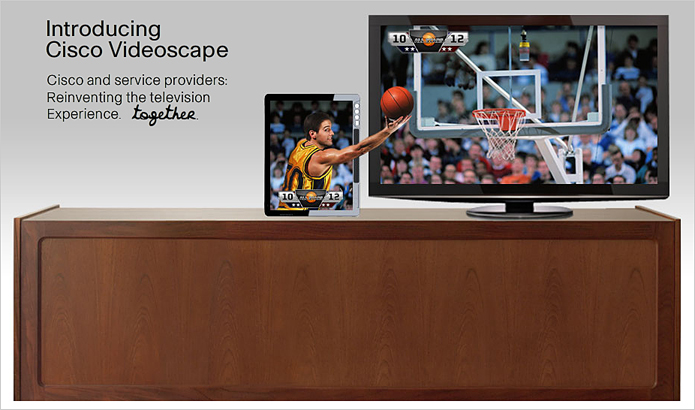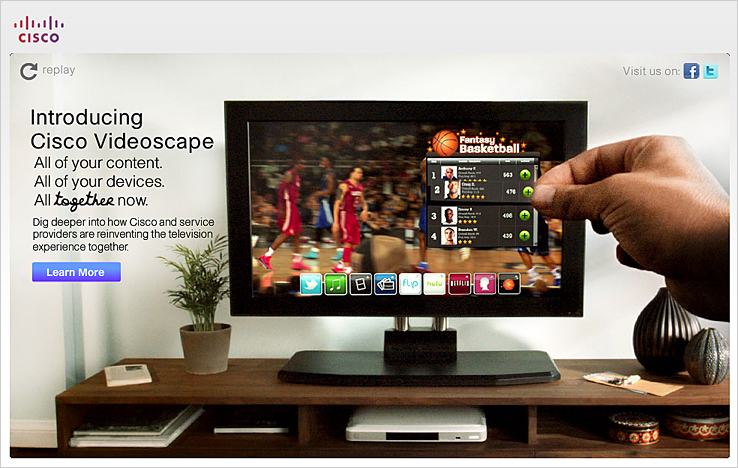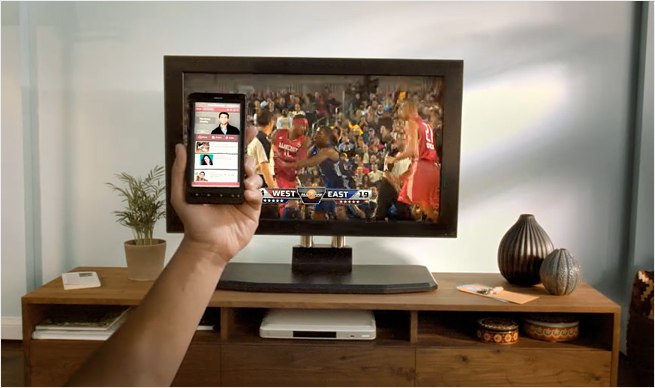Online learning begins to explode into mainstream in blended schools — from Disupting Class posted by Michael Horn
This week, Innosight Institute, where I am the executive director of the education practice, released a landmark report, titled The rise of K-12 blended learning: Profiles of Emerging Models, which profiles 40 different operators leading the rise of K-12 blended learning.
Across America a skyrocketing number of K-12 students are getting their education in blended-learning environments. Over 4 million K-12 students took at least one online course in 2010, according to Ambient Insight, and this space is growing now by a five-year compound annual growth rate of 43 percent—much faster than the growth of charter schooling or other K-12 education reforms, for example. And the majority of this growth is occurring in different types of “blended learning.”
Also see:
- The rise of K-12 blended learning: Profiles of emerging model
and the report itself by clicking the graphic below
A question of balance — by Clive Sheperd
Excerpt:
The issue, as ever, is getting the balance right between taking advantage of new developments as they come available, while continuing to exploit the potential of long-standing approaches.
Also see:
- The New 3 E’s of Education: Enabled, Engaged and Empowered
How Today’s Students are Leveraging Emerging Technologies for Learning - What Do Kids Say Is The Biggest Obstacle To Technology At School? — from ReadWriteWeb.com by Audrey Watters
10 reports on the near future of learning — from EdReformer.com by Tom Vander Ark
From DSC:
In my mind, this area of intelligent systems and agents is one of the most important areas to watch in the years ahead. Such efforts should help us develop sophisticated systems that can help deliver personalized, customized education at the K-12 and higher ed levels…and perhaps will be relevant in the L&D space as well.
The innovations that come from this area may make hybrid-based — as well as 100% online-based learning — incredibly powerful!
If someone can develop such systems and make them available at far cheaper prices than exist today, a quality “Walmart of Education” will truly have been built.
Per the Call for Papers section, the topics for this conference include, but are not limited to:
| Area 1 – Intelligent Systems
– Algorithms – Artificial Intelligence – Automation Systems and Control – Bioinformatics – Computational Intelligence – Expert Systems – Fuzzy Technologies and Systems – Game and Decision Theories – Intelligent Control Systems – Intelligent Internet Systems – Intelligent Software Systems – Intelligent Systems – Machine Learning – Neural Networks – Neurocomputers – Optimization – Parallel Computation – Pattern Recognition – Robotics and Autonomous Robots – Signal Processing – Systems Modelling – Web Mining
|
Area 2 – Agents
– Adaptive Agent Systems – Agent Applications – Agent Communication – Agent Development – Agent middleware – Agent Models and Architectures – Agent Ontologies – Agent Oriented Systems and Engineering – Agent Programming, Languages and Environments – Agent Systems – Agent Technologies – Agent Theories – Agent Trends – Agents Analysis and Design – Agents and Learning – Agents and Ubiquitous Computing – Agents in Networks – Agents Protocols and Standards – Artificial Systems – Computational Complexity – eCommerce and Agents – Embodied Agents – Mobile Agents – Multi-Agent Systems – Negotiation Strategies – Performance Issues – Security, Privacy and Trust – Semantic Grids – Simulation – Web Agents |
.Some of the sessions being offered include:
- Innovative Assessment Techniques
- Teaching the Nontraditional Adult Learner
- Designing Educational Experiences that Promote Deep Learning
- Developing an Academic Honesty Program that Works
- Modeling Writing for Developmental Learners
- Computers in the Classroom: Evidence of Student Engagement (Not Distraction)
- Fostering Student Engagement in Online Learning Environments
- Integrating Emerging Technology in the Classroom and Beyond
- Setting Up Your Hybrid Course for Success
- Engaging Millennial Students in the Basic Course
Putting the Learning in Blended Learning — from Faculty Focus by Ike Shibley, PhD. in Instructional Design
Blended learning involves using a combination of face-to-face interactions and online interactions in the same course. Students still regularly meet in the classroom in a blended course, but the frequency of those meetings is usually decreased. The goal of blended learning is to facilitate greater student learning and could thus fit within a learner-centered paradigm.
Many discussions about blended learning, however, focus not on learning but on blending. “Blended” is an adjective and “learning” is a noun; why has our focus been directed at the adjective? Do we assume, as is often done in the teaching paradigm, that learning is automatically assumed? I think that blended learning has become widely established enough that attention can now be paid to the learning portion of the name.
In higher education learning must be the focus—the push for learner-centered teaching is a noble, pedagogically defensible goal. Improving the cost-effectiveness of teaching should play only a secondary role. An instructor should not begin a blended design by asking how many face-to-face hours are really necessary, even though some administrators may use reduced hours as a starting point. The course should be designed to maximize learning.
Also see:
The Rise of K-12 Blended Learning — Michael Horn
Online learning is sweeping across America. In the year 2000, roughly 45,000 K–12 students took an online course. In 2009, more than 3 million K–12 students did. What was originally a distance- learning phenomenon no longer is, as most of the growth is increasingly occurring in blended-learning environments, in which students learn online in an adult-supervised environment at least part of the time. As this happens, online learning has the potential to transform America’s education system by serving as the backbone of a system that offers more personalized learning approaches for all students.
This week Innosight Institute released a report about this phenomenon and opportunity titled “The rise of K-12 blended learning.”
Written in conjunction with the Charter School Growth Fund and Public Impact, my coauthor and colleague Heather Staker and I use the report to try to bring clarity to a field that has had multiple definitions over what blended learning is. Ours is an overarching one…
More for Less: New Research Points to Blended Learning — from EdReformer.com by Bennet Ratcliff
…which links to “The rise of K-12 blended learning” from the Innosight Institute by Michael Horn and Heather Staker
From DSC:
It shouldn’t surprise anyone who knows my work when I say that I think Sajan George is right on the mark! 🙂
For example, below are the main points of what I heard him say (with some graphics of my own that back up what I have been saying):
Sajan George: The Future of Education
January Series at Calvin College (January 24, 2011)
We are living in a new age, the Conceptual Age — primary skill sets that we now need are for creators and empathizers. Why? Because those two skillsets aren’t easily automated or outsourced (Sajan referenced Dan Pink’s work).
We built our education system in between the agricultural and industrial ages; mass production model was built during a much different time with different needs.
Speed and acceleration of change has greatly increased. At a phenomenal pace!
From DSC:
You may have seen me post this graphic a few times:

Sajan gave an example that focused on an older model of a coffee maker vs. a newer model: Coffee Maker 1.0 vs. Coffee Maker 2.0. Point was that we still need skills, but design, esthetic, and emotion have become more important.
Also, we live in a society that demands Coffee Maker 2.0 — but our educational systems are still offering Education 1.0. We are still batching kids by age, using a 1-to-many model, etc.
We still are offering “Education 1.0” where
- Content is king
- Collaboration is cheating
- Poor performance gets you an F – discouraging
- Teacher role = expert
…but we are living in a “Society 2.0” world
- Experience is king
- Collaboration is encouraged
- Performance is rewarded; like game designers, encouraged to try again
- Teacher and student roles are interchangeable; teacher more of a facilitator
Also, our current methods of educating students is not scalable, not sustainable!
Previous attempts at changing our educational systems have failed because they’ve been trying to fix the status quo of education! It’s a design problem.
From DSC:
You may have seen me post this graphic a few times:
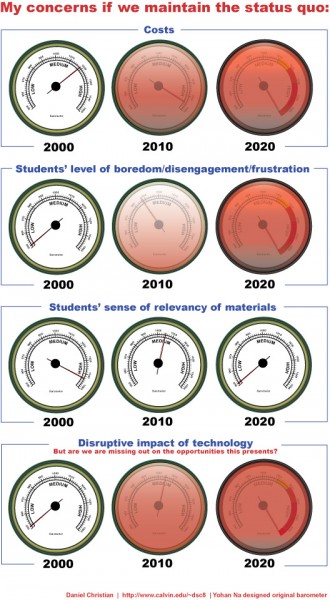
Current educational system needs to be completely blown up and redesigned! We live in a digital world, yet kids sitting in analog world.
Technology that customizes learning – recommendation engines, adaptive learning; personalized/customized learning.
Online learning is scalable, sustainable – while offering instantaneous feedback. Per Sajan, “But it’s happening on the fringes; home school kids; supplemental, etc.”
Hybrid environment – hoping to nationally launch this year
- Each student gets 2 teachers
- Netbook w/ curriculum – w/ lessons loaded
- Learning management system progresses each child at that student’s pace
- Bulk is in online engine
- Teachers don’t have to lesson plan, grade, etc. – so what do they do? The role of the teacher changes to being a facilitator of learning – a coach, mentor, a guide. Can build better, closer relationships.
Use data to differentiate instruction.
Design problem in education.
Hybrid learning <– Sajan’s current work promoting this model; brings power of human interaction with the customization that technology can bring.
From DSC:
You may have seen this graphic I’ve posted a few times — that aims to capture the best of both worlds:
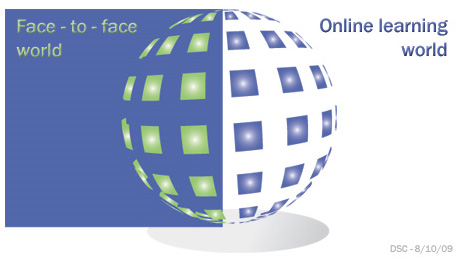
When trying to change things, you need a compelling vision of what you are trying to build/achieve.
From DSC:
You may have seen the vision I was trying to relay here.
From Q&A session…with a hybrid mode:
- Not labeling some kids as struggling students; teachers forced to leave some behind while trying to keep the plates spinning over there for kids who are getting it
From DSC:
The other day, I created/posted the top graphic below. Take the concepts below — hook them up to engines that use cloud-based learner profiles — and you have some serious potential for powerful, global, ubiquitous learning! A touch-sensitive panel might be interesting here as well.
Come to think of it, add social networking, videoconferencing, and web-based collaboration tools — the power to learn would be quite impressive. Multimedia to the nth degree.
Then add to that online marketplaces for teaching and learning — where you can be both a teacher and a learner at the same time — hmmm…
.

.
From DSC:
Then today, I saw Cisco’s piece on their Videoscape product line! Check it out!
.
.
.
.
.
Georgia Tech Center to explore 21st century universities — from CampusTechnology.com by Dian Schaffhauser
The Georgia Institute of Technology is setting up a new center specifically to serve as a living laboratory for testing new forms of education. Driven by the growth of social networking, online learning, and other developments, the Center for 21st Century Universities will enable faculty at the Atlanta institution to experiment with new approaches to curriculum and its delivery. According to former College of Computing Dean Rich DeMillo, who will lead the center, it will also work with national and international groups involved in higher education reform. The first item on the center’s agenda is to develop a seed grant program for promising early proposals.
A Big Idea: Blended CBO — from EdReformer.com by Tom Vander Ark

The nation received a friendly ‘C’ in the annual state of the nation last week. We need quality at scale and there is finally a way achieve it.
More than two million students learn online. The scaled providers (Apex, K12, Connections, Florida Virtual, NC Virtual, and Lincoln Interactive to name a few) could triple in size given 60 days notice and do it with consistent quality. We’ve never had an opportunity like that; it’s only local and state policy that stands in the way of better learning opportunities for several million kids and fast.
Community–based organizations (CBO) build powerful sustained relationships with youth, engage them in developmental activities, and connect them to youth and family services. Many of them are frustrated by working around struggling schools.
If we combine the two assets—online instruction and powerful community connections—we get one big scalable idea: blended CBOs. A blended school model incorporates online learning and onsite support in ways that are often more flexible and cost effective than traditional schools.
Michael Robbins, Department of Education’s Office of Faith-Based Partnerships, is interested in expanding the educational impact of CBOs. He thinks blended CBOs is a big idea. Over breakfast at DC’s Tabard Inn, Michael and I sketched out a couple ways this idea could scale:
The 19,100-student Grand Rapids school district in Michigan launched blended-learning classes this past fall. The district has started with high school social studies and math classes.
“There was some initial resistance from the public—concerned parents with the perception that kids are just going to be stuck in computer labs—but that’s absolutely contrary to what [this] is,” said John Helmholdt, the director of communications for the district. “When you say blended, people don’t understand what that means. It took months of really trying to educate and raise awareness of really what it was we were trying to do.”
Moving to a blended model actually made teacher-student ratios better, according to Mr. Helmholdt, by layering on support-staff members to circulate when the students were completing work online.
In Grand Rapids, the blended classes go through a three-day rotation of face-to-face and online instruction. During the first day, students receive a traditional lecture-based class in a regular classroom where a new concept is introduced. On the second day, the class starts by going over the concept again and then beginning to use some of the online software and support tools that reinforce the concept. On the third day, the students work solely with digital resources. [Rest of article here.]
From DSC:
I am very glad that the Grand Rapids school system is moving in this direction! It is a huge step in the right direction and I congratulate the district’s leadership for their vision and patience while this plane gets off the runway. This endeavor will help the students begin to build digital/information literacy. It will open their minds up to numerous creative possibilities — as well as career opportunities and goals. They are beginning to have “the world as their school“.









